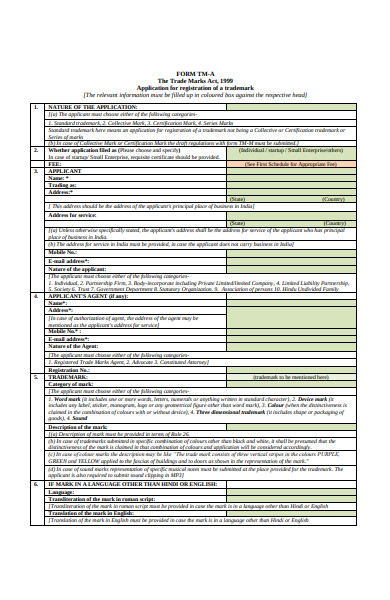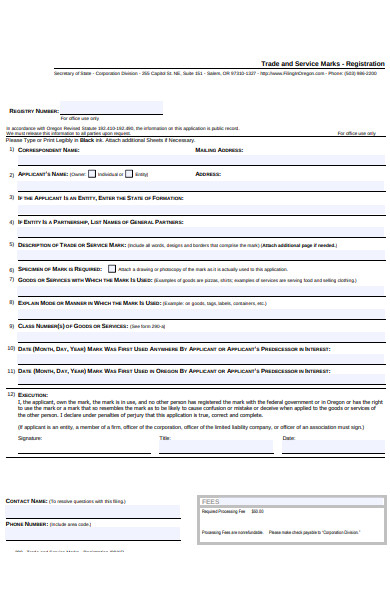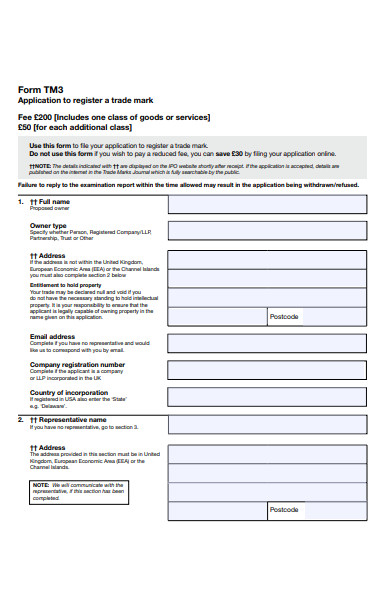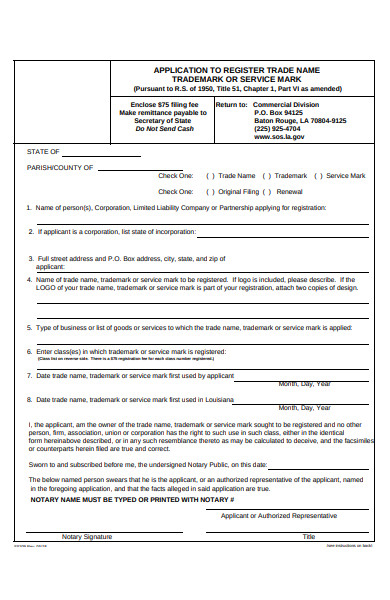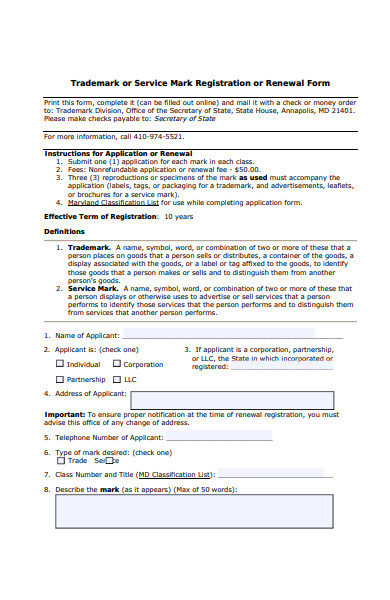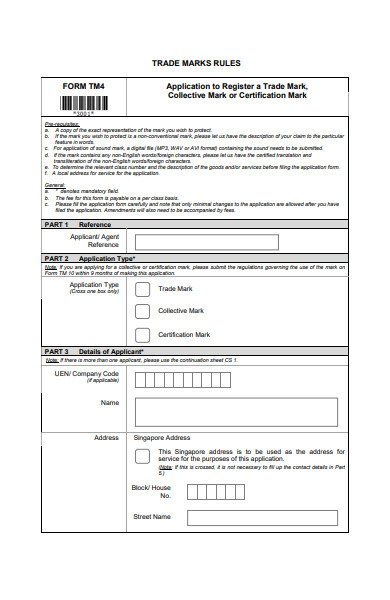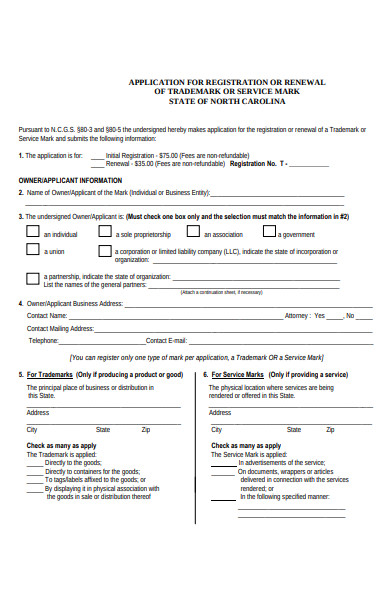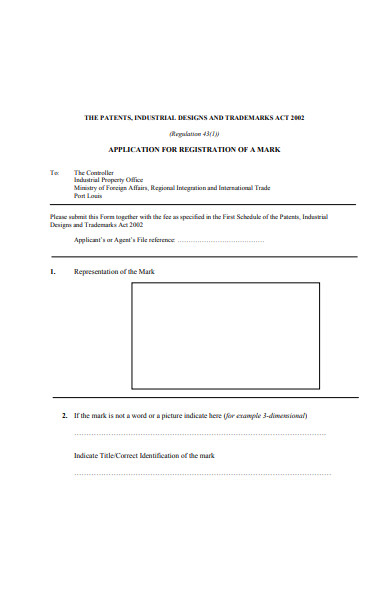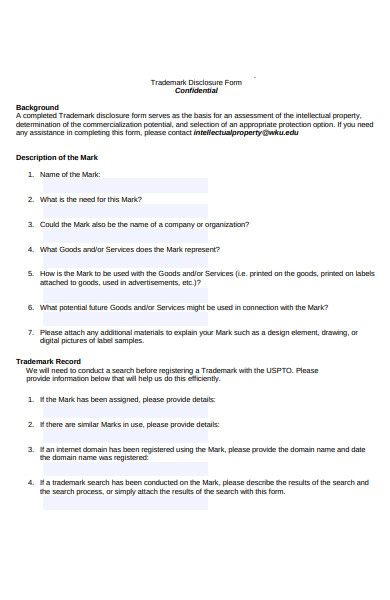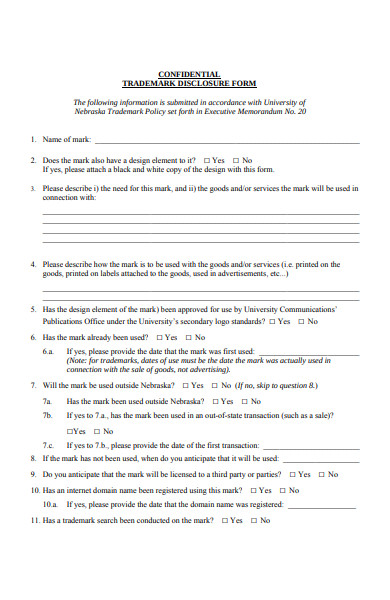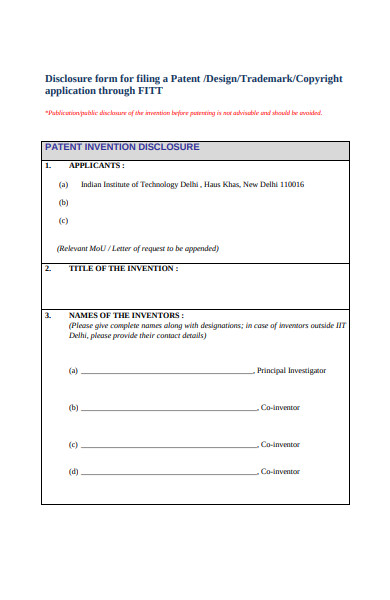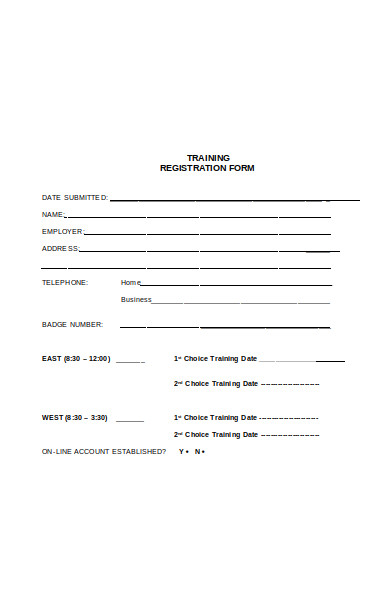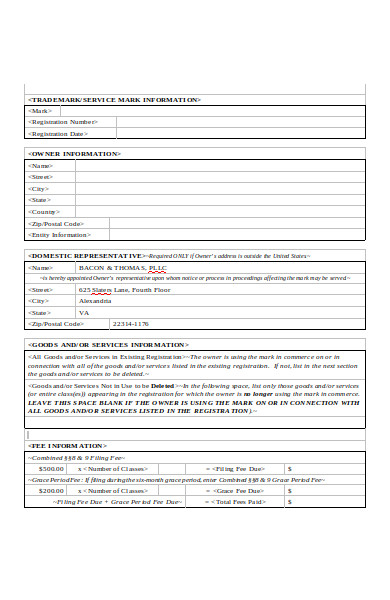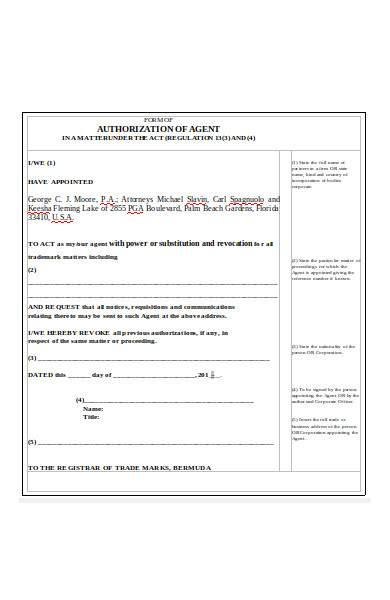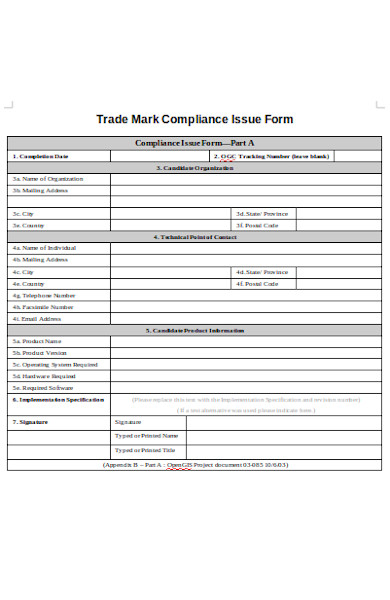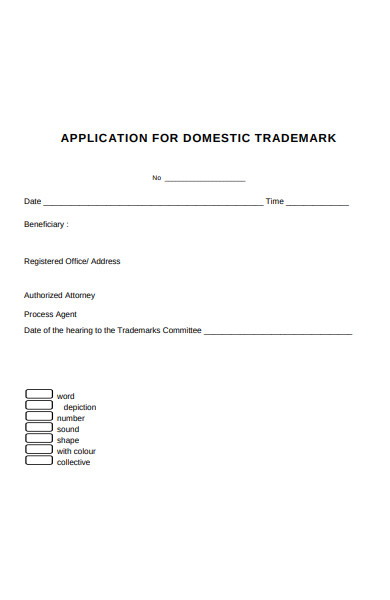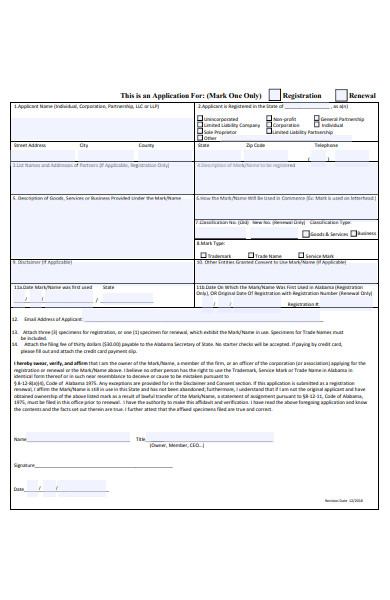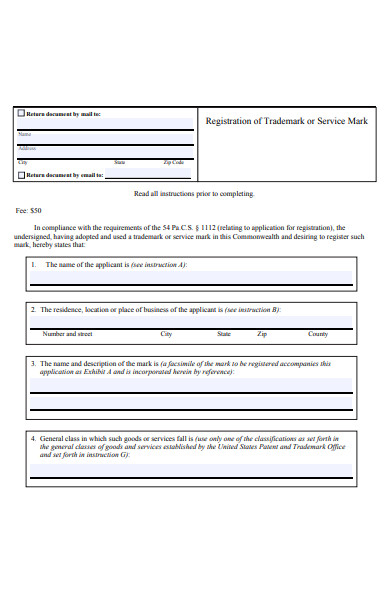Some key phrases leave a great mark to the public like “This Sick Beat” from Taylor Swift’s song called Shake It Off. In addition to pop culture, Paris Hilton is also well-known for “That’s Hot” from her reality show The Simple Life. What both stars have in common is that their signature phrases got trademarked legally. Indeed, you can acquire ownership to some designs or words through registration but qualifications also apply. Anyone who tries to exploit anything trademarked may undergo lawsuit, including those who break the trademark license agreement. Thus, the right thing to do is finalize these ownership terms with trademark forms.
FREE 19+ Trademark Forms in PDF | MS Word
1. Trademark and Copyrighted Forms
2. Trademark Registration Forms
3. Trade and Service mark Forms
4. Trademark Application Forms
5. Trademark or Service mark Forms
6. Trademark Renewal Forms
7. Trademark Rules Forms
8. Trademark Owner Application Forms
9. Designs and Trademark Forms
10. Trademark Disclosure Forms
11. Trademark Confidential Form
12. Trademark Under Section Form
13. Trademark Patient Invention Form
14. Trademark Training Form
15. Trademark Commerce Form
16. Trademark Authorisation Form
17. Trademark Compliance Issue Form
18. Domestic Trademark Form
19. Trademark Register Form
20. Charitable Organisation Trademark Form
How Is a Trademark Form Defined?
For starters, brand names are associated with trademarks. Expect specific words, phrases, names, designs, and symbols to fall under a trademark or service mark. What is the difference between the two? If the trademarked term distinguishes specific goods or products, then it is a trademark. On the other hand, service marks refer to anything identified according to the source of services rather than the products themselves. When you plan to process for trademarks, then completing the required paperwork comes next, and those are the trademark forms.
A trademark form is an official document that tackles about a trademark. Such trademark forms can become specified according to an application, agreement, and more. These legal documents cannot be simply underlooked because there is information present that can be confidential and highly important. In noticing anyone unauthorized who used your trademark, you have the rightful power to file for a lawsuit. Protecting your rights with trademark protection is a big deal, and the forms can help you achieve that.
Is It a Trademark, Patent, or Copyright?
Getting confused with common terms while registering for a trademark can happen for starters. Maybe you assume trademarks are similar to patents and copyrights as there are identical aspects found from each example. While such words all refer to specific ownership, it helps to receive an introduction about the dissimilar factors found from each term. This idea avoids unpleasant circumstances like having wrong expectations and mixing one term to another. Take note of the following facts:
-
Trademark
The significant difference of a trademark from a patent and copyright is its duration. Ownership in trademarks can last for years, and no expiration date becomes given as well. Saying that something can last forever applies to this case, especially when you keep using such trademarks for business. Focus on registering legally, or some claims may fall for revocation because of merely assuming that something got trademarked.
-
Patent
Inventions like machines, devices, industrial or chemical processes, and other related applications would fall under patents. These property rights do not last forever, though, as a specified duration will turn finalized. You can adjust the patent agreement through legal processes, though, in case an extension gets planned. In most cases, patents relating to design will reach up to 15 years, while utilities can be allowed until 20 years from issuance.
-
Copyright
Copyright registration turns recommended if authorship is the primary concern. Someone might try to steal your original projects like songs, books, movies, and other artistic works. As the original owner of such works, then you deserve to register for the copyright to declare it. However, you may authorize others to produce extra copies or similar content with the help of copyright release forms that must have your signature on it. Protection rights here can go up to the lifespan of the author and up to 70 years. Meanwhile, anonymous works may reach from 95-120 years.
Kylie Jenner VS Kylie Minogue: Trademarking Names
In mentioning the name Kylie, which famous Kylie pops into your mind? The reality TV star Kylie Jenner or the Australian singer Kylie Minogue? About their fans via Twitter, it is shown that Jenner has 32.3 million followers, while Minogue has 2.2 million followers as of April 2020. Jenner is in the lead towards Twitter popularity against Minogue, especially with the rising Kylie Cosmetics line. However, the name Kylie is not owned by Jenner but by Minogue herself. Thus, goods and services named Kylie will only be authorized for Minogue. Minogue did the trademark registration early, which grants her the trademark Kylie. When Jenner started filing for trademarking Kylie in 2015, Minogue’s team reacted, which led to opposition claims.
Jenner’s example proves that research and analysis play a significant role before registering for trademarks. All the time, money, and effort given for trademarking would have gotten avoided if Jenner’s team knew ahead about Minogue’s brand on the Kylie name already. Stealing another’s property is unwelcome anyway so the best chance for Jenner is to cosign with Minogue or avoid using the single name Kylie. It is when you are aware of what’s allowed or prohibited that you start finalizing the trademark form you wish to submit.
What Are the Benefits of Registered Trademarks?
Primo Angeli once said, “A great trademark is appropriate, dynamic, distinctive, memorable, and unique.” By keeping that statement in mind, you will have confidence that you decided on the right trademark. You ensure to have it registered for compliance, though. Before you request to make your brand legal, get introduced with the standard advantages to expect from registered trademarks. The benefits consist of the following:
-
Avoids Getting Sued
It is only a claim to own an unregistered trademark since that is not legally yours yet. Even if you assume of trademarking something yet you never registered it, another person could trademark it from you instead. Property rights can get complicated anyway, like what happened to the Barbie versus Bratz dolls battle. According to the New York Post, Mattel (toy company owner of Barbie) had a designer who made the idea of the Bratz doll line. However, such a designer who moved to MGA (toy company owner of Bratz) shared that idea, which led MGA to gain the lucrative success of Bratz that started in 2001. Property rights work similarly to trademarks where ownership battles can take place.
-
Observes Trademark Recognition
In being listed with the other approved trademarks online, people receive identification about your brand immediately. Furthermore, it brings verification that your mark is legal. At least other people will be aware not to use your trademarks already since these properties belong to you. If others want to apply for a trademark as well, then they would avoid using something the same as yours to get approved.
-
Grants the Right for Taking Legal Action
Avoiding to be sued is not the only benefit because you can take action by being the one who processes legal action instead. It is unfair when other people earn profit out of something that belongs to you in the first place. As someone with the authority of owning a trademark, you can speak up and begin litigation to anyone violating such rights.
-
Promotes Respect
Being registered shows that you complied with the rules or agreements. Additionally, it implements respect since people cannot just mess with your rights anymore. Stealing someone’s trademark will end in bad terms only. Just make sure you fully know about the rights and conditions involved in trademarking to avoid believing in incorrect expectations.
How to Process a Successful Trademark Application
The United States Patent and Trademark Office (USPTO) confirms that trademark registration is a legal process governed by U.S. law. Before getting excited to trademark something, there are underlying factors worth recognizing first. Maybe you receive revocation right away for not knowing about the correct processes in applying for a brand. Avoid prolonging the process by being unsure with how the work gets done with the help of these helpful steps for processing a trademark application:
Step 1. Hire a Dependable Trademark Attorney
Going through the process without enough background and knowledge of trademark law is risky since registering here is not just any random sign-up form. Legal rights, protection, and fees are even covered, so it works best to work with an expert, particularly a respected trademark attorney. Attorneys give a bigger chance of succeeding with your application. Be sure to set standards in choosing a lawyer or expert since an unreliable person can hinder success.
Step 2. Meet the Legal Requirements
Before anything else, you should know the qualifications ahead for trademarking. Maybe a phrase you claim to be yours is not federally registrable. In writing down your personal information, everything should be correct. More so, staying on schedule is needed to prevent getting revoked for processing late. USPTO’s site can provide you every single requirement required to complete as you must comply with the Trademark Electronic Application System (TEAS) for a new application.
Step 3. Get the Right Trademark Application Form
While sending applications, it is essential to put down all required information through an acceptable trademark application sheet. There are a variety of examples found in the sample templates above, and you can print or edit those anytime. These documents must become reviewed after filling in the blanks until no mistake will get realized in the end. In applying online, you can choose between two filing alternatives from the TEAS Plus and TEAS Standard. Work with the option that suits you best for trademarking.
Step 4. Visit USPTO’s Website to Search their Database
The Trademark Electronic Search System (TESS) from USPTO is the official database system when you need to look at what trademarks are already available. If your planned mark is already taken, sadly, you cannot apply for it anymore. Otherwise, there will be legal battles to encounter. Besides the registered trademarks, the database also shows other pending applications, so those are still ongoing. Checking from this site enables you to prevent conflict.
Step 5. Define Your Trademark Explicitly
Unclear information of what to trademark leads to easy failure, and you cannot let that happen. Trust on USPTO to give you the acceptable products and services allowed for trademarking. Authorities will understand what you mean by depicting the trademark through a representation. Defining a trademark means that everything is specified to observe proper understanding. Conduct an evaluation if that is understandable since you need to alter it if it fails to deliver clearly.
Step 6. File for Application and Monitor Status
File your registration by submitting the trademark form to the authorities, like the USPTO website. Expect to comply with the applicable fees too because how much it costs can depend on particular circumstances. Processing payments for USPTO will not even accept your refund request, so everything should get finalized and corrected. That way, you will not waste your opportunity to register. After completing, you track the application status via the TESS database to know if that turns approved or not. The protocol is to at least wait from 5-7 days after submitting it. You do not track immediately since the database would still undergo an update first. If dissatisfied with the results, then you contact the right representatives.
FAQs
Do I need to register for trademark?
Registering for trademarks is not mandatory, but you would not receive the protective advantages in ignoring the registration. For example, giving complaints is useless already if someone trademarks a common saying you make because you have not filed for owning it legally. Get protected with your rights by undergoing registration until you can own your trademarks.
Is a trademark attorney required?
Americans need not hire a trademark attorney, given that they are already knowledgeable about trademark law. However, it turns greatly suggested to have an attorney to receive guidance in boosting your success rate to get trademarked. Those who do not reside in the U.S. would be required to hire licensed attorneys though for compliance in dealing with foreign laws.
How can I decide on a strong mark?
Deciding on your trademark can be challenging because you have to be sure of the decision if you file it already. Thus, you ensure to choose a strong trademark like something unique. A unique trademark will not be easily confused with another trademark, and that lets you get away from infringement. You may conduct a clearance search via the internet too to know about what trademarks are already taken or not. You are not allowed to copy anyone’s trademark anyway.
Trademarks are to be treated with respect since anyone with no authority which plans to exploit, like create merchandise of a trademark that does not belong to theirs, will face the consequences in court. To send a statement that you own such rights legally, you better complete your application successfully. Indeed, trademarking can undergo processes that may take longer, but you never have to keep it that way by using professional trademark forms. Such documents grant you permission to protect your rights as soon as possible.
Related Posts
FREE 10+ Procurement Card Forms in PDF DOC
FREE 10+ Pre-Award Forms and Policies in PDF DOC
FREE 10+ Honors Scholar Graduation Forms PDF
FREE 9+ Sample Property Statement Forms in PDF WORD
FREE 14+ Legal Consent Forms in WORD PDF
FREE 7+ Marketing Agreement Form Samples in sample, Example ...
FREE 44+ E Commerce Forms in PDF DOC
10+ Required Forms for Opening and Operating a Bakery Business ...
FREE 7+ Assignment of Lease Forms in PDF DOC
7+ Internet Marketing Business Invoice - PDF - Sample Forms
7+ Free Notary Acknowledgment Forms in PDF
FREE 11+ Legal Agreement Forms DOC
FREE 7+ Alumni Membership Forms in PDF DOC
FREE 5+ Lottery Agreement Forms in PDF DOC
FREE 14+ Trademark Assignment Forms in PDF DOC


